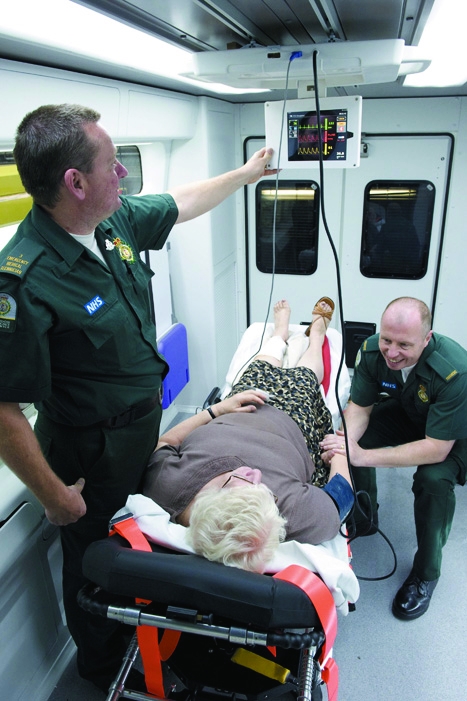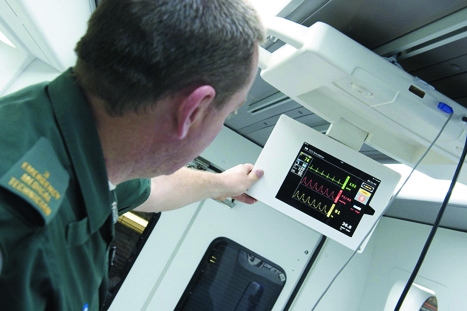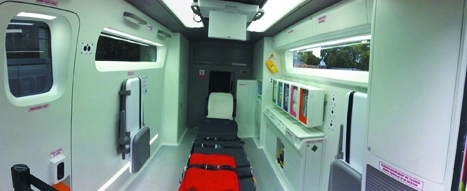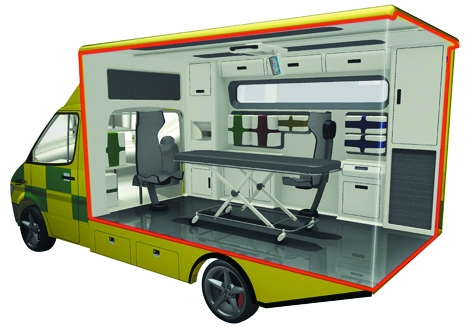Given the astonishing pace of medical technology innovation, you would be forgiven for thinking that the modern ambulance must surely be a slick box of tricks on wheels.
But from a design point of view, the ambulance has changed very little in the past 30 years or so. In fact, the basic concept of ’swoop and scoop’ to hospital that is still largely in place dates back even further – despite changing healthcare paradigms.

The figures are telling. In 2009-10, ambulance crews dealt with 7.87 million emergency calls – yet around 40 per cent did not require treatment in an A&E hospital.
The skills of ambulance staff and paramedics have evolved markedly, as has the technology potentially available to them, but their ambulances have failed to keep up. The problems are numerous but include hygiene and infection control, patient experience and digital communications.
The NHS has recognised the need for change since the 2000s, yet progress has been slow, with some conceptual projects funded but nothing concrete achieved.
However, the latest project to address the issue is altogether more ambitious – aiming to build a full-scale mock-up of the back of an ambulance fit for the 21st century.

The 18-month-long project was led by the Helen Hamlyn Centre for Design at the Royal College of Art in London, alongside the London Ambulance Service, Imperial College Healthcare NHS Trust and the University of the West of England.
’There’s a number of problems with existing ambulances, because they’ve sort of evolved from horses and carts – it’s an old cliché, but they were used in the Crimean War just to cart soldiers back from the front line and get them to some kind of hospital treatment,’ project collaborator Dr Ed Matthews, senior research fellow at the Hamlyn Centre, told The Engineer.
’Nobody, until now, has stood back and looked at the design of an ambulance with what it has to do now, where you’ve got paramedics that are trained to diagnose. They don’t just have to take people straight to A&E; they carry quite sophisticated drugs with them, they prescribe and administer and they can actually discharge people on scene.’
The first rather radical step in terms of research was for members of the Hamlyn design team to ride with an ambulance crew on full 12-hour shifts around London.
The most immediate issue seemed to be a lack of space. The internal structure of an ambulance is very modular and vehicles are often overstocked due to the ’just-in-case scenario’, and sometimes end up running over legal weight. Alternatively, equipment might be missing or batteries discharged. Moreover, there has been virtually no standardisation of ambulance specifications across the UK, which has created logistical and managerial problems for ambulance trusts.

’We started inspecting everything; we dismantled an ambulance and just took everything out in terms of equipment and consumables to understand volumes and where everything needs to be laid out,’ said Gianpaolo Fusari, research associate at the Hamlyn Centre. ’At the same time, we were sketching ideas and doing 1:1 mock-ups and asking paramedics to come back and test these things with us.’
Part of the solution was a ’working wall’ that had all the equipment readily available, including five universal treatment packs containing consumables for commonly occurring call-outs – namely wound dressings, airways and oxygen, maternity, burns and cannulation. ’So that it almost jumps to you rather than going to a cupboard and finding your way,’ Fusari said.
By creating a leaner internal environment, the team was able to free up space and move the patient trolley bed into the middle for 360° access. In current ambulances, the trolley is clamped to the right-hand side of the wall, making it difficult for paramedics to work on the left-hand side of the patient.
Another modification was to include a moulded composite interior with just two components, creating a single seam in the middle, complete with curved, flushed surfaces for shelves and cupboards. This was intended to help with infection control.

’If you look at a standard ambulance, it is full of panels and screws with lots of nooks and crannies – all put together with bits of melamine and Perspex – which gather dirt and bacteria,’ Matthews said.
From a technological point of view, the aim was to choose the right off-the-shelf solutions and ’bolt them together’ as robustly as possible.
There are also three so-called digital communication portals.
The overhead monitor above the patient trolley folds down and carries all the functionality of a Lifepak 15 device, including a defibrillator and a monitor for oxygen saturation and blood pressure. The monitor also has a video link to the receiving hospital doctor or expert consultants for complex cases. Meanwhile, the driver’s console includes satellite navigation as well as the option to see what’s going on in the back.
Finally, there is a handheld digital tablet for administration and entering patient reports. Data from the central monitor is automatically uploaded to it.
’At the moment, [paramedics] write notes on their glove and then transpose those onto a patient’s sheet, and then that gets transposed finally onto the NHS system and becomes digitised – with ours it’s all wireless,’ said Matthews.
The team has now built a full-scale ambulance in the back of a trailer box. It has been tested in clinical trails, where it showed significant improvements over conventional ambulances in dealing with scenarios such as cardiac arrests. Notably, a contamination scenario was performed with a simulated bleeding leg ulcer infected with MRSA. UV staining revealed a nearly 70 per cent drop in simulated infection spread.
“Nobody has stood back and looked at the design of an ambulance and what it needs to do”
Dr Ed Matthews, Hamlyn Centre
The ambulance box is now touring the UK at medical conferences in the hope of raising awareness and drumming up further funding. Although there are promising leads, there is no main commercial partner as yet. Part of the problem lies with the conservative nature of the ambulance manufacturers, according to the team.
’They’re very comfortable and happy to sit on their hands. They’re paid £170,000 for an ambulance and we look at it and say: “Well there’s a £15,000 chassis – how much does it cost to build a caravan on the back of that and then fit all the electronics?” They’re spoon-fed by the NHS in a way and they’re not used to thinking “how do we raise our game to get a bit more of the market share”.’
Fusari added: ’We’re in a position where the paramedics want it, and the NHS thinks it’s fantastic, but they say “if you build it we’ll buy it” – and the builders say “yes it’s great” and “if the NHS buys it then we’ll build it”.
Keyfeatures lifesaver
The ambulance is designed to meet the needs of modern paramedics
- Single ’working wall’ with modular treatment packs for common call-outs
- Central patient trolley for easy access and improved patient experience
- Central console with Lifepak 15 functionality, plus video link for consultation
- Moulded composite interior with curved surface to enable improved infection control




Report highlights significant impact of manufacturing on UK economy
I am not convinced that the High Value Manufacturing Centres do anything to improve the manufacturing processes - more to help produce products (using...